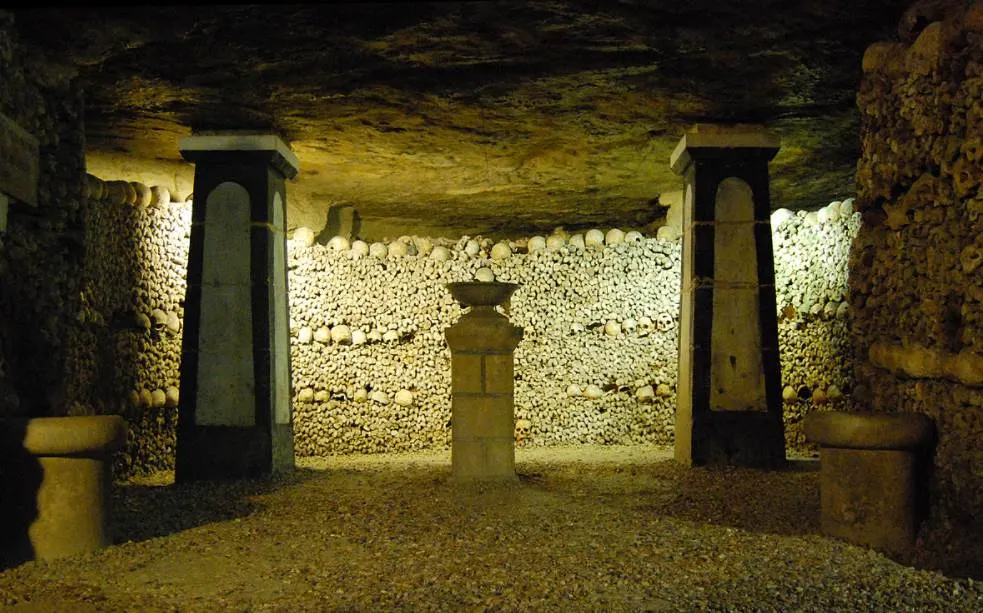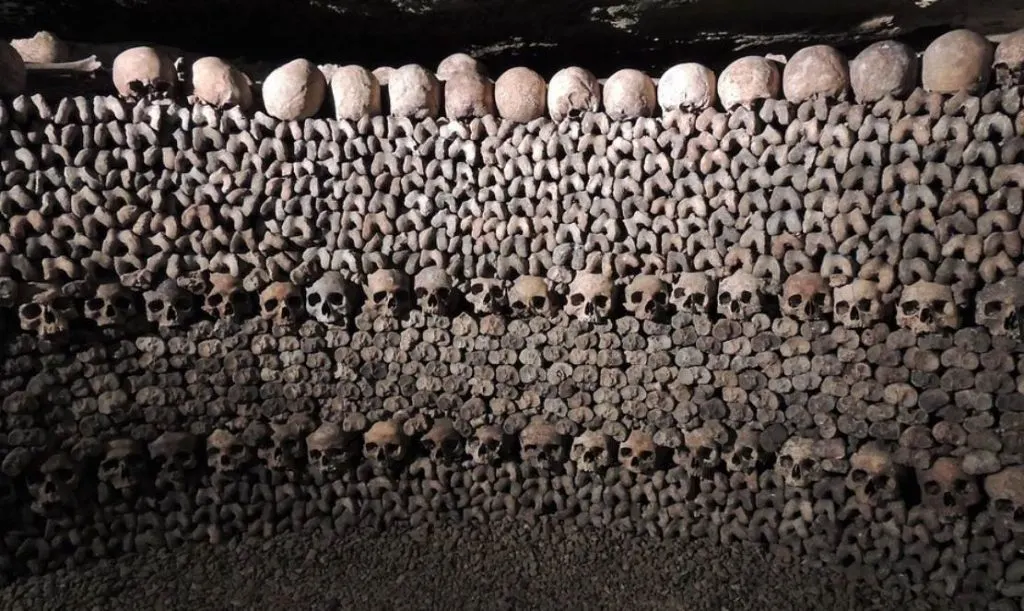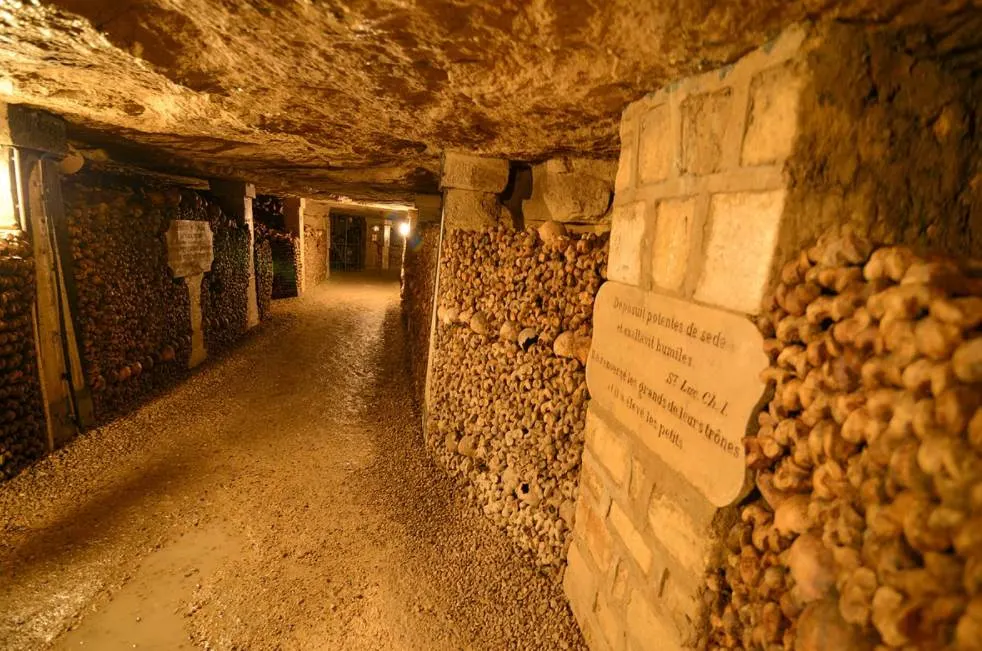What are the odds of an immense underground burial ground becoming one of the most popular tourist attractions in Paris, right?
This was certainly not the goal of the people establishing this ossuary in the late 18th century but that’s exactly what happened.
Let’s take a closer look at some of the most interesting facts about the Catacombs of Paris, one of the most peculiar museums you’ll ever come across.
1. It’s located in mine shafts of the ancient stone quarries of Paris
The Catacombs of Paris is the name of the collection of ossuaries that were built inside the shafts of the limestone mines of Lutetia, the ancient city that became Paris.
These mines were used to quarry “Lutetian limestone,” a type of stone found in the region in and around Paris. Most of the city was built using these stones, but many of these shafts fell in disuse as the quarries ran dry.
The main entrance of the Catacombs is located at the Place Denfert-Rochereau, a public square in the Montparnasse neighborhood of Paris.
Other popular attractions in the area are Tour Montparnasse and the Panthéon of Paris, as well as the magnificent Luxembourg Palace and its amazingly landscaped Luxembourg Garden.
The square is located near the Denfert-Rochereau station which makes it easily accessible by the Paris Metro.

2. The ossuaries were established to replace a crumbling medieval cemetery
The Roman city of Lutetia extended on the Left Bank of the River Seine which means that the city’s first burial grounds were located here as well in what was then the city’s southern outskirts.
Following the Fall of the Western Roman Empire, the city expanded on the Right Bank of the River Seine. The main cemetery of the medieval city was located right next to “Les Halles,” the main marketplace of Paris back then.
Starting in 1130, this cemetery was referred to as the “Holy Innocents’ Cemetery.” Multiple centuries later, this cemetery was packed with remains of the dead into a mound that reached a height of over 2 meters (6.6 feet).
In the year 1780, a gruesome collapse of one of the cemetery’s basements urged King Louis XVI to do something about the situation, and the idea to stack the remains into the former mine shafts came about.

3. It’s estimated that over 6 million people are buried in the Catacombs
Burials at the Saint Innocents Cemetery were forbidden following the basement collapse in 1780. It would take 6 more years before the mine shafts were completed to serve as the permanent resting place of countless dead Parisians.
Starting in 1786, covered carts full of remains were transported at night from the cemetery to what we know today as the “Catacombs of Paris.”
Even though Les Innocents was the largest cemetery in Paris with over 2 million remains, the remains of other cemeteries were stacked into the mine shafts as well.
These include the cemeteries of Saint-Étienne-des-Grèsone, Madeleine Cemetery, Errancis Cemetery, and Notre-Dame-des-Blancs-Manteaux. This resulted in an estimated 6 million people being buried inside the Catacombs.

4. The Catacombs didn’t get their current layout until the year 1810
Because of the urgency over the first couple of years, stacking the remains wasn’t an organized process. It wasn’t until the year 1810 that an effort was doe to transform the ossuaries into a place that can be visited.
Mining engineer and politician Louis-Étienne Héricart de Thury (1776-1854) started working on renovating the Catacombs by integrating walls of human remains, archways, and even decorations.
The Catacombs of Paris ended up being transformed from a pile of skulls and bones into one of the most peculiar tourist attractions you’ll ever come across.

5. It has been 1 of 14 City of Paris Museums since 2013
Believe it or not but the Catacombs are one of the 14 museums in Paris that are managed by “Paris Musées,” a public institution that manages these attractions.
The Catacombs were included in the list which also features the Musée d’Art Moderne de la Ville de Paris (MAM Paris), located at the Palais de Tokyo, the Carnavalet Museum, dedicated to the history of Paris, and the Petit Palais, the smaller brother of the Grand Palais, to name just a few.
The Catacombs were added to Paris Musées in 2013 and have been a popular tourist attraction in the capital of France since their establishment in the 19th century.

More interesting facts about the Catacombs of Paris
6. The Catacombs of Paris extend south of the Barrière d’Enfer or the “Gate of Hell.” This gate marked the southern entrance of the city of Paris and consisted of a pair of tollhouses that were established around the same time as the Catacombs in 1787.
Even though this gate has a scary name, it has nothing to do with the catacombs as it was named after the nearby “Rue d’Enfer.” Where the name comes from remains unclear but it’s probably a wrong translation of the Latin “Via Inferior.” The “Via Superior” is the modern-day “Rue Saint-Jacques.”
7. The collapse of a basement wall of the Saint Innocents Cemetery in 1780 wasn’t the start of an investigation to move the cemetery to another location, it just made the matter more urgent.
Just 6 years earlier in 1774, a commission was established to investigate the potential of using the former mineshafts of the limestone quarries as an ossuary. These mine shafts were being strengthened as many collapsed the following years.

8. The timing of relocating the remains of the dead to the Catacombs was just as peculiar as the attraction itself. That’s because it was about the same time that the French Revolution started in 1789, a period in which many people lost their lives during riots.
This also means that many people who died during this tragic period in French history were buried here shortly after.
9. Even though the Catacombs have been a popular tourist attraction in Paris since their creation, they were briefly closed to the public between 1833 and 1850.
The church opposed that human remains were put on public display during this period. After they reopened, the Catacombs gradually grew in popularity and now welcome an estimated 450,000 visitors every year.
10. There’s a sign just above the entrance of the Catacombs that reads “Arrête! C’est ici l’empire de la Mort.” This translates to “Stop! This is the Empire of the Dead.”



